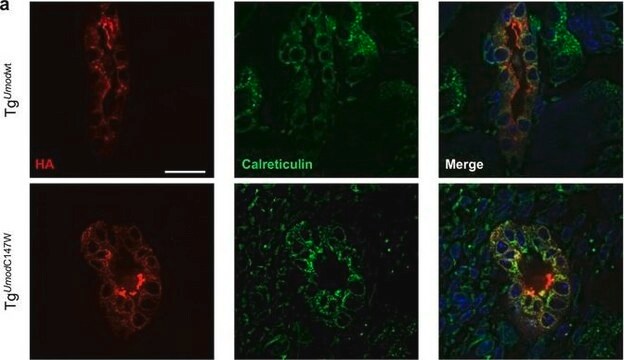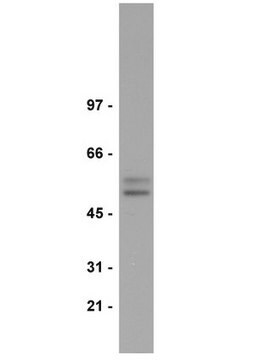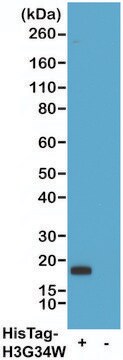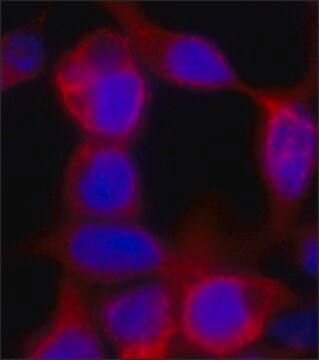05-949
Anti-Histidine Tagged Antibody, clone HIS.H8
clone HIS.H8, Upstate®, from mouse
Synonim(y):
HIS Tag Antibody
Zaloguj sięWyświetlanie cen organizacyjnych i kontraktowych
About This Item
Kod UNSPSC:
12352203
eCl@ss:
32160702
NACRES:
NA.43
Polecane produkty
pochodzenie biologiczne
mouse
Poziom jakości
forma przeciwciała
purified antibody
klon
HIS.H8, monoclonal
reaktywność gatunkowa (przewidywana na podstawie homologii)
all
producent / nazwa handlowa
Upstate®
metody
immunocytochemistry: suitable
immunoprecipitation (IP): suitable
western blot: suitable
izotyp
IgG2b
Warunki transportu
dry ice
docelowa modyfikacja potranslacyjna
unmodified
Opis ogólny
His-Tag is a series of at least 6 histidine residues used as a tag motif at the N- or C-terminus of recombinant proteins. The relatively small size of this tag vs. other commonly used tags such as GST (30 kDa) makes it less likely to interfere with target protein structure or function. Its small size also makes it more suitable for use under denaturing conditions. His tags are most often used for affinity purification and binding assays. His tags bind to nickel or cobalt ions with high affinity, and this interaction with metal ions is the basis of many his-tag based affinity media. The His Tag epitope is widely used to detect expression of recombinant proteins in bacterial, yeast, insect,and mammalian systems.
Specyficzność
Recognizes tag sequence HHHHHH on either the N- or C-terminus of any recombinant fusion protein; no other amino acids surrounding the 6x-His tag sequence are required for the recognition of the 6x-His tag.
Immunogen
6x His synthetic peptide.
Zastosowanie
Immunocytochemistry:
2 μg/mL of a previous lot of antibody showed positive immunostaining for His tagged Akt1/PKBα in transfected HeLa cells.
Immunoprecipitation:
This antibody has been reported by an independent laboratory to immunoprecipitate His Tagged proteins.
2 μg/mL of a previous lot of antibody showed positive immunostaining for His tagged Akt1/PKBα in transfected HeLa cells.
Immunoprecipitation:
This antibody has been reported by an independent laboratory to immunoprecipitate His Tagged proteins.
Research Category
Epitope Tags & General Use
Epitope Tags & General Use
Research Sub Category
Epitope Tags
RNA Binding Protein (RBP)
Epitope Tags
RNA Binding Protein (RBP)
This Anti-Histidine Tagged Antibody, clone HIS.H8 is validated for use in IC, IP, WB for the detection of Histidine Tagged.
Jakość
Routinely evaluated by western blot and immunocytochemistry on transfected HeLa cells.
Western Blot Analysis:
0.5-2 μg/mL of this lot detected His tagged Akt1/PKBα in RIPA lysates of transfected HeLa cells.
Western Blot Analysis:
0.5-2 μg/mL of this lot detected His tagged Akt1/PKBα in RIPA lysates of transfected HeLa cells.
Postać fizyczna
Format: Purified
Purified
Purified mouse monoclonal IgG2b in buffer containing PBS, pH 7.4 with 0.05% sodium azide.
Przechowywanie i stabilność
Stable for 1 year at -20°C from date of receipt.
Handling Recommendations:
Upon first thaw, and prior to removing the cap, centrifuge the vial and gently mix the solution. Aliquot into microcentrifuge tubes and store at -20°C. Avoid repeated freeze/thaw cycles, which may damage IgG and affect product performance.
Handling Recommendations:
Upon first thaw, and prior to removing the cap, centrifuge the vial and gently mix the solution. Aliquot into microcentrifuge tubes and store at -20°C. Avoid repeated freeze/thaw cycles, which may damage IgG and affect product performance.
Komentarz do analizy
Control
RIPA lysates of transfected HeLa cells.
RIPA lysates of transfected HeLa cells.
Inne uwagi
Concentration: Please refer to the Certificate of Analysis for the lot-specific concentration.
Informacje prawne
UPSTATE is a registered trademark of Merck KGaA, Darmstadt, Germany
Oświadczenie o zrzeczeniu się odpowiedzialności
Unless otherwise stated in our catalog or other company documentation accompanying the product(s), our products are intended for research use only and are not to be used for any other purpose, which includes but is not limited to, unauthorized commercial uses, in vitro diagnostic uses, ex vivo or in vivo therapeutic uses or any type of consumption or application to humans or animals.
This page may contain text that has been machine translated.
Kod klasy składowania
10 - Combustible liquids
Klasa zagrożenia wodnego (WGK)
WGK 2
Certyfikaty analizy (CoA)
Poszukaj Certyfikaty analizy (CoA), wpisując numer partii/serii produktów. Numery serii i partii można znaleźć na etykiecie produktu po słowach „seria” lub „partia”.
Masz już ten produkt?
Dokumenty związane z niedawno zakupionymi produktami zostały zamieszczone w Bibliotece dokumentów.
Klienci oglądali również te produkty
Michael W Lawlor et al.
Human molecular genetics, 22(8), 1525-1538 (2013-01-12)
No effective treatment exists for patients with X-linked myotubular myopathy (XLMTM), a fatal congenital muscle disease caused by deficiency of the lipid phosphatase, myotubularin. The Mtm1δ4 and Mtm1 p.R69C mice model severely and moderately symptomatic XLMTM, respectively, due to differences
Directed evolution of anti-HER2 DARPins by SNAP display reveals stability/function trade-offs in the selection process.
Houlihan, G; Gatti-Lafranconi, P; Lowe, D; Hollfelder, F
Protein engineering, design & selection : PEDS null
Alexa Patoine et al.
PloS one, 12(9), e0184568-e0184568 (2017-09-08)
BRIL (bone-restricted IFITM-like), is a short transmembrane protein expressed almost exclusively in osteoblasts. Although much is known about its bone-restricted gene expression pattern and protein biochemical and topological features, little information is available for BRIL physiological function. Two autosomal dominant
Felizza F Gunderson et al.
Infection and immunity, 83(3), 1008-1018 (2014-12-31)
Legionella pneumophila, the primary agent of Legionnaires' disease, flourishes in both natural and man-made environments by growing in a wide variety of aquatic amoebae. Recently, we determined that the Cas2 protein of L. pneumophila promotes intracellular infection of Acanthamoeba castellanii
ATX1-generated H3K4me3 is required for efficient elongation of transcription, not initiation, at ATX1-regulated genes.
Ding, Y; Ndamukong, I; Xu, Z; Lapko, H; Fromm, M; Avramova, Z
PLoS Genetics null
Nasz zespół naukowców ma doświadczenie we wszystkich obszarach badań, w tym w naukach przyrodniczych, materiałoznawstwie, syntezie chemicznej, chromatografii, analityce i wielu innych dziedzinach.
Skontaktuj się z zespołem ds. pomocy technicznej












